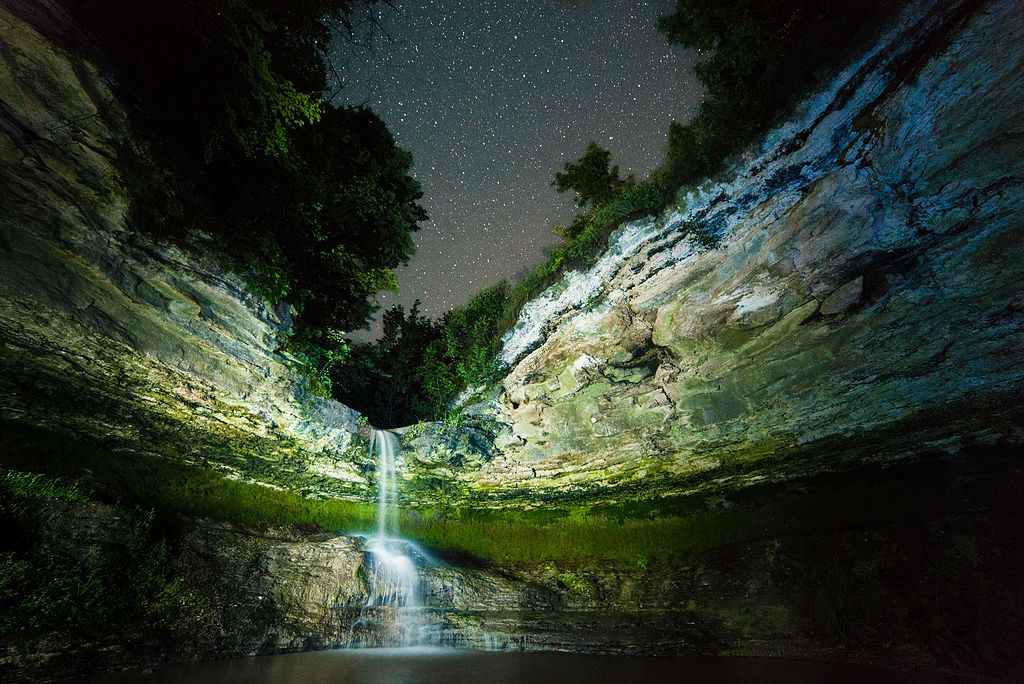First place: The limestone of Stopića Cave, Serbia. Photo by Cedomir Zarkovic, CC BY-SA 4.0.
The tangy butterscotch glow of a limestone cave in Serbia soaking up the slanting sun. The emerald green of lush German forest and pond covered with lush weeds and trees. The stark white and blue of a Ukraine snowscape 2,028 meters above sea level, where snowy peaks meet cloud and sky.
The colors of nature burst from the 15 finalists of Wiki Loves Earth, the photo contest now in its third year of crowdsourcing gorgeous landscapes from more than 13,600 participants. The top 15 photos this year come from Serbia, Bulgaria, Nepal, Estonia, Ukraine, Spain, Austria, Brazil, Germany, and Thailand.
National judging in 26 regions sorted through 115,000 photos and sent the best to international judges from Ghana, Germany, South Africa, Kosovo, France, India, Estonia, Indonesia, and Bulgaria.
This year, the contest expanded to include a collaboration with the United Nations Educational, Scientific and Cultural Organization, better known by its acronym UNESCO. Contestants were invited to upload photos in a separate category for UNESCO biosphere reserves in 120 different countries.
You can see more about Wiki Loves Earth on its website, and this year’s jury report on Commons.
Second place: Pobiti Kamani, Bulgaria, the only desert in Eastern Europe. Photo by Diego Delso, CC BY-SA 4.0.
Third place: Tangye, Mustang, Nepal. Photo by Patricia Sauer, CC BY-SA 4.0.
Fourth place: Ahja River, Estonia. Photo by Külli Kolina, CC BY-SA 4.0.
Fifth place: Biały Słoń, the former Polish Astronomical and Meteorological Observatory, now located in Ukraine. Photo by Khoroshkov, CC BY-SA 4.0.
Sixth place: Northern Inland Fuerteventura, Spain. Photo by Tamara Kulikova, CC BY-SA 4.0.
Seventh place: Vääna River, Estonia. Photo by Kristoffer Vaikla, CC BY-SA 4.0.
Eight place: Part of the Schladming Tauern. Photo by Jörg Braukmann, CC BY-SA 4.0.
Ninth place: Tokivske waterfall in Ukraine. Photo by Ryzhkov Sergey, CC BY-SA 4.0.
Tenth place: Lençóis Maranhenses National Park, Brazil. Photo by Joao lara mesquita, CC BY-SA 4.0.
Eleventh place: the same location as #5, but taken on a cold winter day. Photo by Taras Dut., CC BY-SA 4.0.
Twelfth place: Wettenberger Ried, a protected forest in Germany. Photo by Andreas Weith, CC BY-SA 4.0.
Thirteenth place: Khao Sam Roi Yot National Park in Thailand. Photo by KOSIN SUKHUM, CC BY-SA 4.0.
Fourteenth place: Terra Ronca State Park, Brazil. Photo by Rafael Rodrigues Camargo, CC BY-SA 4.0.
Fifteenth place: Tara in Serbia. Photo by Vladimir Mijailović, CC BY-SA 4.0.
Jeff Elder, Digital Communications Manager
Wikimedia Foundation
Originally published on the Wikimedia blog at https://blog.wikimedia.org/2016/11/25/wiki-loves-earth-2016-winners/.
Continue reading “The top fifteen phenomenal winning photos from Wiki Loves Earth”













































